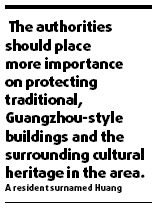Society
Upheaval of urban renewal
By Qiu Quanlin (China Daily)
Updated: 2010-02-26 07:47
 |
Large Medium Small |
GUANGZHOU: Li Aiqun moved out of Enning Road in Guangzhou, capital of Guangdong province, two years ago.
Amid sky rocketing housing prices and limited supplies, many would consider Li lucky to live in a new apartment.

Having frequently been to the neighborhood where she grew up to catch up with old friends and relatives, Li said: "I miss the people here all the time."
She is one of the many residents in Liwan district's Enning Road who were forced to relocate after a major renewal project began in the area in 2008.
Following the renovation of Enning Road, authorities in Guangzhou announced another ambitious 100 billion yuan ($14 billion) facelift in January, which means demolishing more than 10 percent of the old town's built-up areas and relocating up to 600,000 people.
"Old buildings are torn down. For those of us affected by the renewal, the renovation means an end to long-term friendships with neighbors. We cannot visit old friends as often as before," 65-year-old Li said.
Under the plan, a total of 10.5 million square meters of old buildings will be demolished, according to sources with the Guangzhou urban planning authority.
Public opinion on the project has been solicited by the authority, which placed on its website a preliminary urban renewal framework for the development from this year to 2020.
Initial results from the consultation, which will last until the end of this month, indicate that a majority of the people who responded are in support of the renewal plan, sources with the authority said.
"While the renovation plan is good, the authorities should place more importance on protecting traditional, Guangzhou-style buildings and the surrounding cultural heritage in the area," said a resident surnamed Huang.
The authority stressed that public participation will be encouraged in drawing up a comprehensive renewal plan, as protecting Guangzhou's monuments and heritage was a long-term and challenging goal.
It is the largest old town renovation plan by the local government, which aims to free up land and beautify the urban landscape, since the government announced a massive urban redevelopment project in downtown Haizhu district two years ago.
Under the plan, old buildings in Haizhu were scheduled for repair on the south bank of the Pearl River, which required the relocation of some 20,000 people.
Meanwhile, the new renewal plan will cover many historic heritage sites and monuments and will revitalize 54 sq km of old towns stretching across Yuexiu, Liwan and Haizhu districts.
Cultural heritage projects and the protection of monuments are paid for by the district and municipal government.
Accordingly, the new plan will be financed by the municipal government, though authorities are considering bringing outside investment in on the project.







